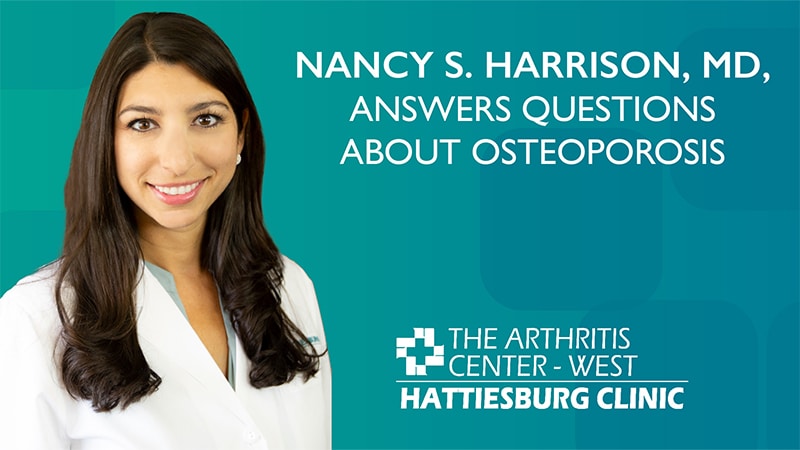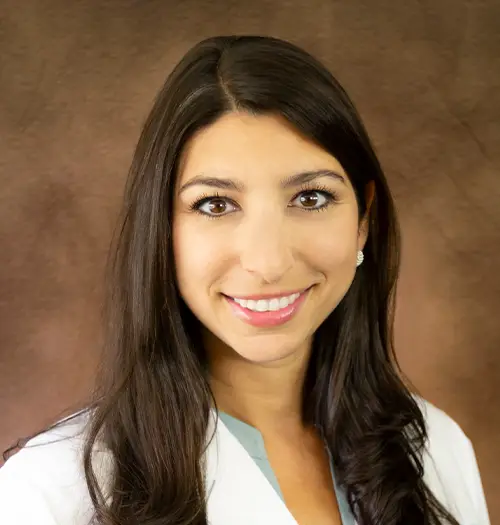Nancy S. Harrison, MD, Discusses Osteoporosis
Nancy S. Harrison, MD, a physician with Hattiesburg Clinic The Arthritis Center – West, recently discussed osteoporosis, who it affects, fractures resulting from the condition and how to be tested.
“Osteoporosis is when a patient’s bones become brittle, which puts them at high risk of fractures,” Dr. Harrison said. “Patients with osteoporosis have low bone mass and decreased bone strength due to disruption of the normal structure of the bone.”
According to the National Osteoporosis Foundation, this condition affects 10 million Americans and another 44 million have low bone density, which places them at increased risk for developing osteoporosis.1Postmenopausal women over 65 years of age are the most common patients seen with osteoporosis, but there are several other risk factors. Race, body frame and weight, family history, history of fractures, dietary deficiencies, certain medications and endocrine disorders are factors that could lead to the development of osteoporosis. Smoking and drinking alcohol can also be a source for this condition.
Fragility fractures are associated with osteoporosis. Fragility fractures are bone fractures that occur from standing height or from two feet or less, without major trauma. A traumatic fracture occurs from high sheer force, such falling from a six-foot ladder or from a high-speed motor vehicle accident. When a fragility fracture occurs, it is recommended that the patient be evaluated for osteoporosis treatment.
Screening for osteoporosis starts at age 65 for women, and perhaps earlier if there are risk factors. The screening tool is called a dual energy X-ray absorptiometry (DEXA) screening. A DEXA screening, or bone density test, will provide the physician with a score that determines if a patient has osteoporosis. If the score is normal, repeat screening is recommended every two to three years. If it is moderate or shows signs of osteopenia, then a fracture risk assessment tool, also known as FRAX is uses to assess patient risk. If the patient is rated at high risk, treatment is recommended. The patient can also receive a diagnosis of osteoporosis without a fracture, so routine screens are advised.
Harrison has a few tips to help improve bone health:
- Take in an appropriate amount of calcium and vitamin D. Harrison recommends a daily dose of 1200 milligrams of calcium and 1000 units of vitamin D. A patient may incorporate these through diet or supplements. Sunlight is an additional source of vitamin D.
- Patients should also quit smoking and avoid heavy alcohol use.
- Exercise regularly. Harrison suggests weight bearing exercise, like walking. Weight bearing exercises help stimulate the bone remodeling process. Patients should exercise 30 minutes a day five times a week.
Talk to your primary care physician if you have concerns about osteoporosis and request a referral to The Arthritis Center – West. Call (601) 288-7500 for more information.
About Hattiesburg Clinic The Arthritis Center – West:
Hattiesburg Clinic provides diagnostic work-up and treatment of patients with rheumatic disease. Board-certified rheumatologists implement a comprehensive team approach to provide therapies for such disorders as rheumatoid arthritis, systemic lupus erythematosus, polymyositis, scleroderma vasculitis and related connective tissue diseases.
About Hattiesburg Clinic:
Hattiesburg Clinic is Mississippi’s largest privately-owned, multispecialty clinic. More than 60 years after its beginning, the clinic has grown to over 450 physicians and providers, caring for patients in more than 17 counties in South Mississippi. Along with over 2,500 professional staff employees, these physicians and providers come together for a common purpose, to serve the over 500,000 community members who live and work in South Mississippi every day.

